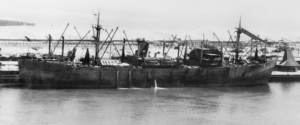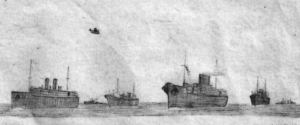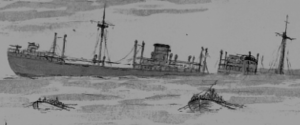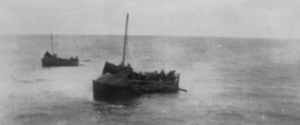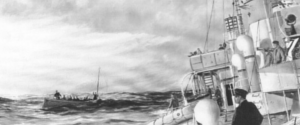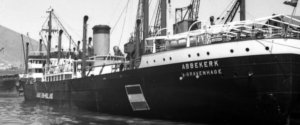Tjilitjap evacuation: “We were human cargo”

26 February 1942. More and more troops from all over the island arrive at Tjilatjap, uncertain of what is to come and anxious to leave the island. They are not impressed with the ship that will be taking them.
When they (the troops) did reach the waterfront, they found it in indescribable confusion. Five or six commands were trying to evacuate through this sole remaining open port at the same time, and no co-ordinating authority seemed to exist. Fifteen or twenty ships lay in the harbour, boats and lighters plying between them and the shore. There were two wooden wharves. (…) At the latter, two ships lay, one moored outside the other, their sides raised high above the dock planking by the tide. The outer ship was the Kota Gedeh (..) The ship against the wharf was the 12000 ton Dutch freighter Abbekerk, which had been reserved to take the US Air Corps units out of Java. Her rusty sides gave point to a story current on the waterfront that she had been sunk at Singapore. (..) there was a single stairway, not more then 3 feet wide, to serve both ships.
In the book ‘they fought with what they had’, Walter D. Edmonds describes the history of the US Air Forces in the Philippines and Java in the last days of 1941 and 1942
At Bandoeng, central Java, the remaining staff of HQ FEAF (Far East Air Force) formed a motor convoy consisting of 17 cars, one bus, and two trucks, struck out for the southern port of Tjilatjap (pronounced chill-a-chap), 160 miles away. We would pass through such exotic-sounding places as Oedjoengbroeng, Tjitjalengka, Tasikmalaja, Bandja, Madjenang, and Wangon. All smelled of dead fish! A volunteer member of the N.E.I. armed forces, a sergeant, was our guide and interpreter. We arrived at Tjilatjap at about 1600. There, we joined a growing group of Americans from units on the island, all hoping to escape the advancing Japanese. We bid a grateful goodbye to our Dutch guide, who declined to leave with us, saying Java was his home, and it was his duty to defend it.
That evening, we boarded a decrepit-looking – but very serviceable – Dutch freighter, named the ABBEKERK. Its few cabins went to badly injured Navy personnel, some officers, and a few civilians. There were no other living quarters or facilities for human beings. We were human cargo. But this was our only hope for freedom, so we were very glad to be there. Ultimately 1500 men would crowd the decks and holds.
Corporal Bill Heath, HQ Far East Air Force
When we arrived there, everything was in a state of utter confusion. A large number of boats was noisily loading and unloading supplies. The first I saw was a two-stacked destroyer silently sneaking down the channel towards the ocean. We passed amidst the numerous warehouses and between various anti-aircraft installations until we finally came to the ship on which we were to leave, the Abbekerk. As I walked on down towards her I was touched with the pitiful signs of anxiety that I saw around me. On all sides were vast stores of Air Force supplies, bales of parachutes, boxes containing cameras and everything else that was vital for the carrying-out of aerial warfare. Scattered about were officers and enlisted men waiting to receive the word to board ship. Many of these men had first arrived from the Philippine Islands and they were so anxious that they did not know whether to believe or disbelieve each command as it came along. The whole situation was thoroughly disorganized.Lower picture: ‘Some 11th and 22nd Squadron personnel awaited boarding the Dutch ship ‘Abbekerk’ at Tjilatjap.’ (Source: Pictorial History of the 7th Bombardment Group/Wing 1918-1995 (1998 7th BG Historical Foundation) from Wilbur W. Mayhew on page 86.)
Flight surgeon Captain James E. Crane, Far East Air Force
One of the units that is to be evacuated by Abbekerk is ground personnel of 11th and 22nd Squadron (7th Bomb Group). They arrive by train en have taken a number of .50 machineguns from bombers that were destroyed on the ground. That opportunity to enhance the defences is welcomed by the crew of Abbekerk.
Those guns were off course made to fit on planes not on a ship. So second engineer Piet Kerklaan went ashore to a factory and took several metal pipes back to the ship. These pipes were welded on the railing around the length of the ship. This way we could mount them anywere the were needed.
Jacob Visser Third Mate of Abbekerk
Harry Tweedale van het 232 Squadron RAF has – in constant retreat – arrived at Java, via Sumatra.
After ten days in Batavia, we were suddenly called together. Thirty of our men (fitters etc) were sent to a drome to assemble some kites for the Americans. The rest of us were put on a train. We didn’t know where we were going. We continued through the night and next day through the most magnificent scenery- mountains, rainforest and jungle – until in the early evening we found ourselves in a small port called TJILATJAP. This cheered us up enormously, although we still didn’t realise how desperate the situation in Java was.
We were put on the cargo ship ‘Kota Gede’, a Dutch ship that lay next to the ‘Abbekerk’, one of our original convoy out of England. Then it had carried our Hurricanes in crates, now it carried us and as many other men as could out of here.
Harry Tweedale, 232 squadron RAF
The loading continued under lights. At ten o clock the whine of the air-raid sirens came. The lights quickly went out on the docks, but the lights on the ship remained lit, as the switch couldn’t be found. For a few long minutes our ship was a perfect target.
‘Turn out those lights!’
The shouts came from the dock and the ship. Then a few started shooting at the lights with their .45 before the switch was found. For almost an hour I crouched in the darkness near the sailors, waiting for the attack. The all-clear signal was finally heard. The lights went on, and the loading of the ship was resumed.
My Fighting Congregation By Chaplain William C. Taggert (US Army)
Meanwhile the large Japanese strike force ‘Kido Butai‘ has taken on supplies in Starring Bay, Celebes, after the raid on Darwin. Today the fleet sets sail to the Indian Ocean. Its main goal is to eliminate the remainder of the British fleet and support the assault on Burma. In that, they have to prevent allied ships to reinforce Java. And – very important for this story – to destroy anything that tries to leave the Dutch East Indies. This huge fleet, consisting of 6 aircraft carriers, over 200 planes and more than 20 cruisers and destroyers now sails a westerly course to the Indian Ocean. The next days this course will take her exactly south of Java…..

